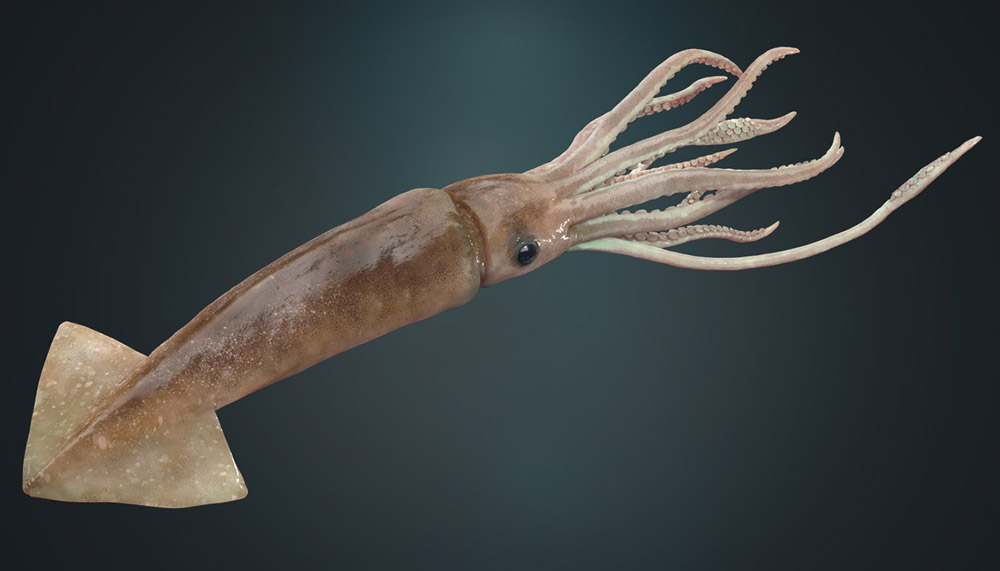
🦑 Introduction: The Fascinating World of Squid Fishing 🎣
Ever wondered how to catch the mysterious and elusive squid? Perhaps you’ve savored its unique taste in a dish and thought about how it got from the ocean to your plate. Well, you’re in for a treat! In this guide, we’ll dive deep (pun intended) into the various ways to catch these cephalopods and the equipment needed to make your squid fishing venture a success.
🌊 Ways to Catch Squid
🟡 Jigging: The most popular method! Use a squid jig with luminous colors to attract and hook them.
🟡 Trawling: Capture multiple squid by dragging a net through squid-rich waters.
🟡 Hand-Lining: For those who like a direct approach, use a line and sinker to get up close and personal.
🎣 Essential Fishing Equipment
🔵 Squid Jigs: Specialized lures with spikes to ensure a successful catch.
🔵 Rod and Reel: Choose a medium to light tackle for jigging.
🔵 Trawl Nets: If you’re looking to catch in bulk, this is your go-to.
🔵 Luminous Accessories: Squid are attracted to light, so consider glow sticks or underwater lights.
😋 Flavorful Journey: Savoring the Squid
There’s nothing quite like the taste of fresh squid! In cooking, squid is renowned for its:
🟢 Tender Texture: When cooked just right, it’s soft and succulent.
🟢 Mild Flavor: A delicate taste that absorbs seasonings beautifully.
🟢 Versatility: From crispy calamari rings to sumptuous squid ink pasta, the culinary possibilities are endless.
🔶 Ready to embark on this squid-tastic journey? 🌊🦑 Let’s dive in!
💢It is very important to know! Squids are nocturnal and deep-sea animals. It is better to catch them from a boat. There are few places on land where squid can be caught from shore. Don’t forget that they throw up ink while defending (take care of your clothes and eyes). Use especially glowing lures to catch them.
How to Catch Squid: A Comprehensive Guide for Beginners and Experts Alike
The principles of catching salmon, pike, bass, flounder, or other fish have some general tendency. But with squid, the situation is completely different. Fishing for squid requires the angler to have a clear understanding of the specific species of squid, to select the correct bait and tackle, and to follow some fishing rules. This article will tell you how to quickly and correctly catch an overthrown batch of squid from the shore or offshore at any time of the day!
A Deep Dive into Squid Fishing: A Comprehensive Review

Brief Overview of Squid and Their Appeal to Anglers
Squid, fascinating and elusive cephalopods, have long captivated the hearts of anglers worldwide. With their unique biology, mesmerizing color-changing abilities, and delicious culinary potential, squid fishing has become a popular pursuit for both novice and experienced fishers. As highly intelligent creatures with lightning-fast reflexes and a penchant for hiding in the depths, successfully catching squid is both a thrilling challenge and a rewarding accomplishment.
To Provide a Detailed Guide on Catching Squid
This article aims to provide a comprehensive review of various squid fishing techniques, gear, and strategies that have proven effective in catching these enigmatic creatures. With a focus on equipping anglers with the knowledge and skills necessary to master squid fishing, this guide will delve into the intricacies of their behavior, preferred habitats, and seasonal patterns. By dissecting each aspect of squid fishing, this article serves as an invaluable resource for those looking to add the squid to their angling repertoire or simply improve their existing cephalopod-catching abilities. Stay tuned for a wealth of information and expert insights that will undoubtedly enhance your squid fishing adventures.
Squid Biology and Behavior: Mastering the Art of Catching Squid
Types of Squid Commonly Targeted by Anglers
Squids are a diverse group of cephalopods, with over 300 species found worldwide. However, only a handful of these species are commonly targeted by anglers. Among the most popular are the European squid (Loligo vulgaris), the Japanese flying squid (Todarodes pacificus), and the California market squid (Doryteuthis opalescent). Each of these species presents unique challenges and rewards for fishers, as they differ in size, distribution, and behavior.
Squid Anatomy and Features Relevant to Catching Them
Understanding squid anatomy is crucial to developing effective angling strategies. Squids possess two long tentacles, equipped with suckers or hooks, used for capturing prey. In addition, they have eight arms, lined with numerous suckers, which play a role in manipulating and securing their prey. Squid’s ability to change color rapidly, thanks to specialized cells called chromatophores, helps them blend into their surroundings, making them difficult to locate.
Their jet-propulsion system, which involves expelling water from a specialized cavity (the mantle), enables them to move swiftly and escape predators or angler’s lures. Knowing these features can help anglers refine their techniques and select the appropriate gear for successful squid fishing.
Squid Habitat and Preferred Conditions
Squids are found in various marine environments, from shallow coastal waters to the deep ocean. They generally prefer areas with rocky or structured bottoms, which provide hiding spots and abundant prey. Many species are also known to inhabit areas with strong currents, as these areas offer a constant supply of food. Understanding these preferences can help anglers pinpoint potential squid hotspots and increase their chances of a successful catch.
Seasonal Patterns and Spawning Behaviors
Squid display specific seasonal patterns and spawning behaviors that can significantly impact their availability and catchability. In many regions, squid tends to be more active during spring and summer months, as water temperatures rise and food sources become more abundant. During these seasons, squid often moves closer to shore to breed and lay their eggs, making them more accessible to anglers.
🔶 Understanding local squid populations’ spawning patterns can provide valuable insight into when and where to target these elusive cephalopods. By timing fishing trips to coincide with peak spawning activity, anglers can improve their chances of encountering and successfully catching squid.
Equipment and Gear: Essential Tips and Techniques for Novice and Expert Anglers

Rods and Reels
✅ Recommended lengths and types
Selecting the appropriate rod and reel for squid fishing is crucial for achieving optimal results. Anglers typically use light to medium spinning rods, ranging from 7 to 9 feet in length. These rods offer a balance between casting distance and sensitivity, allowing for precise jig placement and detection of subtle squid bites. When it comes to reels, 2500 to 3000-size spinning reel, loaded with a smooth drag, is often sufficient for most squid fishing scenarios.
✅ Pros and cons of using squid-specific gear
While general-purpose rods and reels can be effective for squid fishing, specialized squid gear can provide certain advantages. Squid-specific rods, such as the Daiwa Emeraldas series, are designed with parabolic action to enhance jig movement and reduce the chances of pulling hooks from lightly hooked squid. However, the squid-specific gear may be less versatile for other types of fishing, and the investment may not be justifiable for casual or occasional squid anglers.
Line and Leader Considerations
Braided line in the 10-20 lb range is popular among squid anglers for its sensitivity and low stretch, allowing for better bite detection and hooksets. A fluorocarbon leader of similar strength is often used for its low visibility and abrasion resistance, increasing the chances of a successful catch. Leader length can vary, but 3-6 feet is a common starting point.
Jig Selection
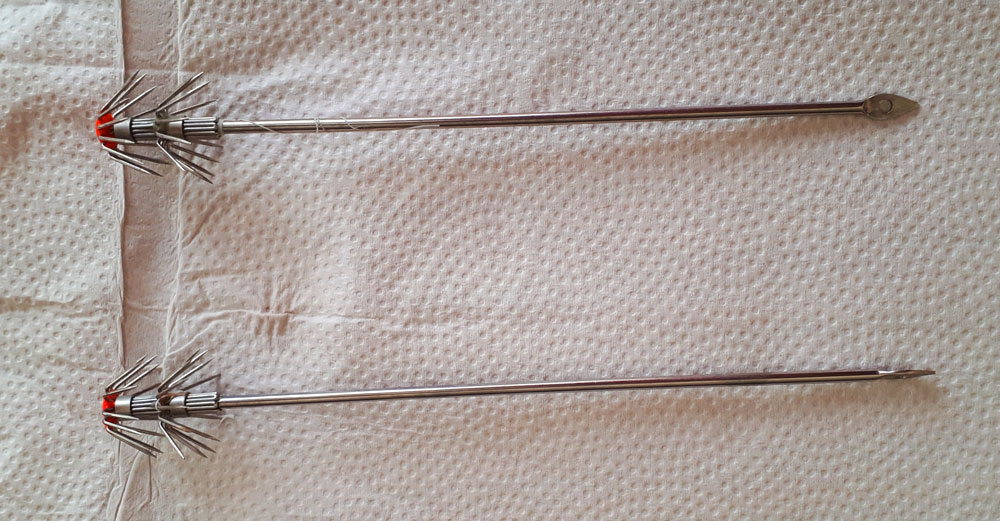
✅ Types of jigs
Squid jigs, or “egi” in Japanese, come in various shapes, sizes, and designs. They typically feature a weighted body and a set of upward-facing barbs or spikes. Jigs can be grouped into several categories, such as cloth-covered jigs, which offer a more natural feel for the squid, and hard-bodied jigs, which provide durability and a unique action in the water.
Size, color, and weight considerations
Jig size, color, and weight can significantly impact your success in catching squid. Smaller jigs (2.5-3.0 size) often yield better results by appealing to a wider range of squid sizes. Popular colors include red, pink, green, and chartreuse, with luminous or reflective finishes for added attraction. Weight selection is dependent on water depth and current conditions; heavier jigs may be necessary in deeper or faster-moving water.
Accessories
✅ Nets
Using a net is highly recommended when landing squid, as it minimizes the risk of pulling hooks free and reduces the chances of being inked. A long-handled net with a fine mesh is ideal, allowing for a gentle scoop from behind the squid while keeping a safe distance.
✅ Storage solutions for jigs
Proper jig storage is essential for maintaining its effectiveness and preventing damage. Specialized squid jigs storage options, such as Daiwa’s Egi Wallet or Emeraldas Egi Holder, can protect jigs from tangling and help keep them organized for easy access during your squid fishing adventures.
Techniques and Tactics: Expert Tips for Catching Calamari on Your Next Fishing Trip
Casting and Retrieval Methods
When squid fishing, casting distance, and accuracy play a crucial role in maximizing your chances of success. To cover a larger area, make long casts and retrieve the jig slowly, incorporating pauses to allow the jig to sink to the desired depth. Varying retrieval speeds and incorporating quick twitches can help mimic the natural movement of prey and entice squid to strike.
Working the Jig
✅ Darting action
Imitating the darting movement of baitfish is essential when working your squid jig. To achieve this, give your rod a sharp upward flick, followed by a controlled drop, allowing the jig to flutter downwards. This action will create an erratic and enticing motion that can trigger a squid’s predatory instincts.
✅ Depth control
Controlling the depth of your jig is vital in targeting squid effectively. Squids are often found near the bottom or at midwater depths, so adjust your retrieval speed and pauses to ensure your jig remains in the strike zone. Pay attention to your line’s angle and watch for subtle line movements, indicating a squid has grabbed the jig.
Identifying Productive Squid Fishing Spots
Squid are attracted to structure and cover, making areas with rocks, seaweed, piers, and break walls prime locations for fishing. Look for locations with a mix of sand, weed beds, and rocky outcrops, which provide ideal hunting grounds for squid. Clear water and good tidal flow can also contribute to productive squid fishing.
Strategies for Boat and Land-based Fishing
For boat-based anglers, drifting over known squid grounds while working the jig can prove effective, allowing you to cover a wide area and locate active squid. Adjust your drift speed to ensure your jig stays in the strike zone.
Land-based anglers can benefit from scouting locations during low tide to identify structures and potential squid-holding spots. Long casts and fan-casting techniques can help cover more ground and increase your chances of finding squid.
Night Fishing Tips
Squids are often more active at night, making it a prime time for targeting them. Fishing near lighted areas, such as piers, docks, and bridges, can increase your chances of success, as squid are attracted to the light and the baitfish it draws in. Use luminous or reflective jigs for added visibility, and bring a lantern or headlamp to illuminate your fishing area and aid in detecting bites.
Catching and Handling Squid: Unraveling the Mystery of Catching These Fascinating Cephalopods
Detecting Squid Strikes and Setting the Hook
Detecting a squid strike can be challenging, as they often grab the jig without any significant tug or pull. Watch for subtle changes in your line’s behavior, such as a sudden slackening or a change in angle. When you suspect a squid has taken your jig, lift the rod tip gently to ensure the spikes are securely embedded in the squid’s tentacles. Avoid jerking or striking hard, as this could dislodge the jig or damage the squid’s delicate appendages.
Fighting and Landing Squid
Squids are not known for their fighting abilities, but they can still put up a spirited tug. Maintain constant pressure on the squid to prevent it from releasing the jig, and reel it in slowly and steadily. As the squid approaches, be prepared for it to make a last-ditch attempt to escape, potentially releasing a cloud of ink. Keep your cool and maintain control of the line as you bring the squid in close.
Using a Net to Land Squid
Landing a squid with a net is the preferred method for minimizing the risk of losing your catch and reducing the likelihood of ink-related messes. When the squid is near the surface, approach it from behind and scoop it up with the net in a single, smooth motion. Be cautious not to spook the squid, as it may jet backward and potentially dislodge the jig or squirt ink.
Tips for Minimizing Ink Mess
Squids have the ability to release ink as a defense mechanism, and this can create a mess if not handled carefully. To minimize the ink mess when landing and handling squid, follow these tips:
| Tips for Minimizing Ink Mess | Explanations |
|---|---|
| Use a net | Using a net to land squid helps prevent ink from being released in your direction, making the process cleaner and more manageable. |
| Keep the squid in the water | By giving the squid a few moments in the net while still submerged, you allow it to release any remaining ink away from you. |
| Handle with care | Holding the squid firmly yet gently when removing it from the net minimizes stress and avoids triggering further ink release. |
| Prepare a dedicated cleaning area | Setting up a designated cleaning station away from your main fishing area reduces the risk of ink stains and mess during squid processing. |
Practical Tips, Tricks And Techniques On How To Catch Squid
Depending on the type of squid, they can live either near the coast or in a warm current near a bay. This means that you will be fishing either from the shore or from the boat. This is the first thing to decide whether you want to catch squid on the shore or you want to hunt it at night from a boat.
Useful Video – Beginners Guide Squid Fishing Tips Catching Find Tutorial Jig How TO
How To Catch Squid From Shore
If you decide to fish for squid from the shore, then the first thing you need is the right equipment. Pick up jigs in various colors and sizes. Next, all you need is a fishing rod.
The first way to catch squid anywhere from the shore is to assume that they are already found in the coastal waters where you are fishing. Even if your gaze did not notice the squid in the water column and you think that they are not nearby, this does not mean that they really are not there. I ran into squid several times in those places where, in my opinion, there could never be squid and I had to run to my tackle bag and urgently look for jigs there.
So the very first and basic rule is to take jigs with you whenever you go fishing. This is a very good practice because I often see anglers find squid, try to catch them with hooks, and of course, they do not succeed. All these tiny squid jig needles are there to make sure that the squid is firmly hooked as it wraps its tentacles around the bait. It won’t work with regular fish hooks.
If you notice a squid chasing your lure and trying to catch on to it, put the squid jig in the water as soon as possible. Don’t try to get the squid out of the water until it is near the jig and notices it. They usually immediately switch to the jig and try to attack it by releasing the ink.
Another popular way to catch squid is to use a special metal lure with spikes on which the small fish is planted and used as bait. Hang one of these lures with freshly caught fish about a meter under a small float, cast the attachment 10-15 meters from the shore, and wait. The moment the squid starts tugging at your bait and trying to drag it under the water, you can be sure that it is holding the bait securely.
Once the squid is hooked, you can begin to gently and carefully pull it out of the water. Accuracy and smoothness are needed here to avoid rupture of the legs that are attached to the bait. As soon as the squid rises from the water column, it will start spitting ink, so be extremely careful and, as soon as you can handle it, turn it away from you so that it can spit out all of its art back into the water. And make sure there are no strangers nearby, otherwise, the squid may give them a dose of ink.
When you pick up a squid, grab it by the torso or by the eyes, but not too close to the tentacles, otherwise, it may bite you with its beak. Then simply remove the fixture and place the squid in a bucket or ice bath.
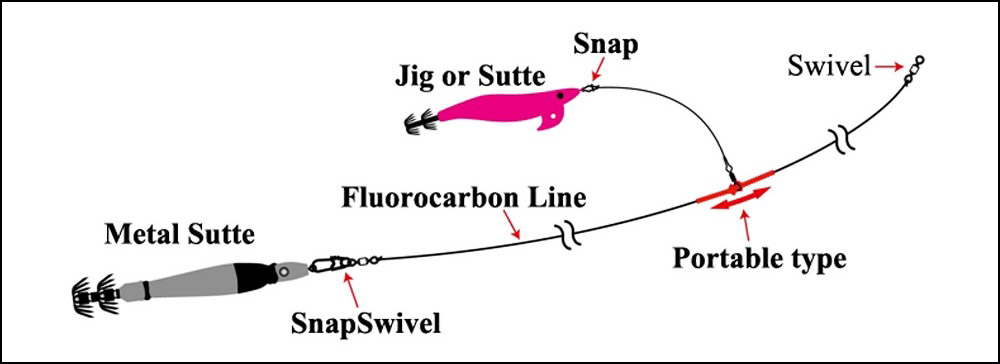
Shore Fishing: Where You Can Find Squid
✅ I have collected for you a few places where squid can be found most often:
💥 Jetties. This is perhaps the most popular place to find squid and almost every pier you pass will be stained with ink from the many squids catches. Most of the squid I met on the piers, under which there are sand and algae. This is a paradise for squid nesting. It is easy to fish from the piers and use a jig and rod. The time of day is of great importance here. Usually, late afternoon and early evening are the best times to catch squid. But I come to the pier early to take a better place for myself.
Squid can also be caught in the middle of a sunny day if you lower the jig to the pylons and it will attract the attention of any squid that is hiding in the shade. Besides, some squid move with the tide past the docks, so if you are fast enough you will have time to catch a couple before they move on. Many jetties produce squid during the day, but prime time is always dark.
💥 Rocks. If you’re going to fish near the rocks, make sure you have a couple of squid jigs with you, as there are a lot of them in these areas. Try not to fish in deep places near the rocks, as the jig is very often gets tangled there. Moreover, if you can see the bottom and can control your bait, you will most likely catch more squid than if you fish at depth.
A fishing rod is your best tool for catching squid from rocks. You just need to reel it back with a couple of sharp movements to get the jig working. Any squid in the area you cast will see your bait and will certainly follow. In deeper rocky areas, you can even use the fish on the spiked bait, but this will only bring a good catch in very calm conditions. Therefore, in most cases, the prawn-type squid jig works very well.
As in the previous case, late afternoon or evening is the best time to fish for squid. But on the rocks, the fisherman should be extra careful. Because when you can’t see the bait, it gets harder to fish. In addition to squid, large cuttlefish live on the rocks, which are also excellent prey. Most importantly, do not forget that they also have a huge supply of ink with which they are ready to splash you!
💥 Beaches. Here we will not consider surfing beaches with white water and huge waves. You will almost never find squid in these conditions. But there are plenty of sheltered beaches all over North America with reefs and algae that squid adore. Many fishermen do not notice these places and in vain, since they are almost always rich in large and tasty squid.
My only advice is to keep the squid away from the sand. Any contact of the squid with the sand will make your fishing terrible. The sand is almost impossible to clean from the skin of the squid and it takes a very long time to clean the tiny particles of sand. And almost 100% of the time, you will hear sand crunching when you start chewing squid. When fishing in sandy areas, first drop the squid into the bucket before removing the jig.
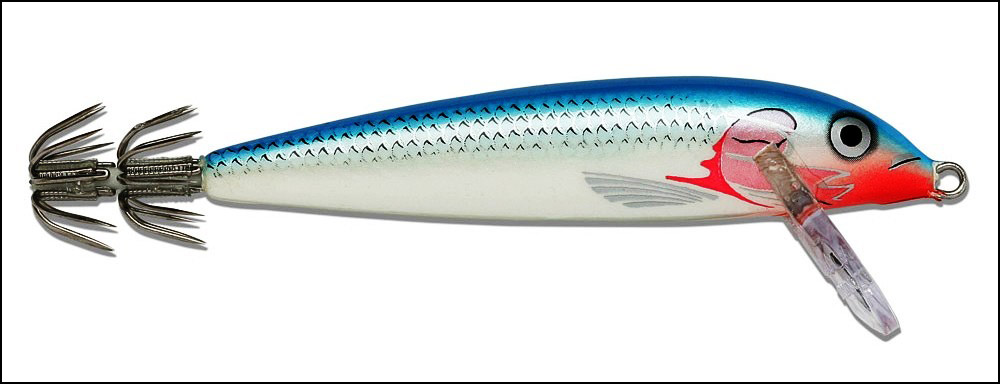
Pros of Catching Squid From the Shore
Catching squid from the shore is not for everyone, and at some points, it is often more difficult than fishing from a boat. but when you improve your skill, you can bring home whole buckets of squid without ever getting into the boat.
Another advantage of shore fishing is that you can fish for squid all year round if you want unless the water is very stormy. Some of the brightest and most memorable nights can be associated with coastal squid fishing when you bring home a huge number of these creatures.
Cons of Catching Squid From the Shore
As convenient and attractive as fishing for squid from the shore may seem, you will never catch the same amount of squid that you can catch from a boat. Of course, many squid species live near the coast, but the largest and most numerous of them prefer the ocean since there is much more prey and a place for them to hunt.
How to Catch Squid While Fishing Offshore
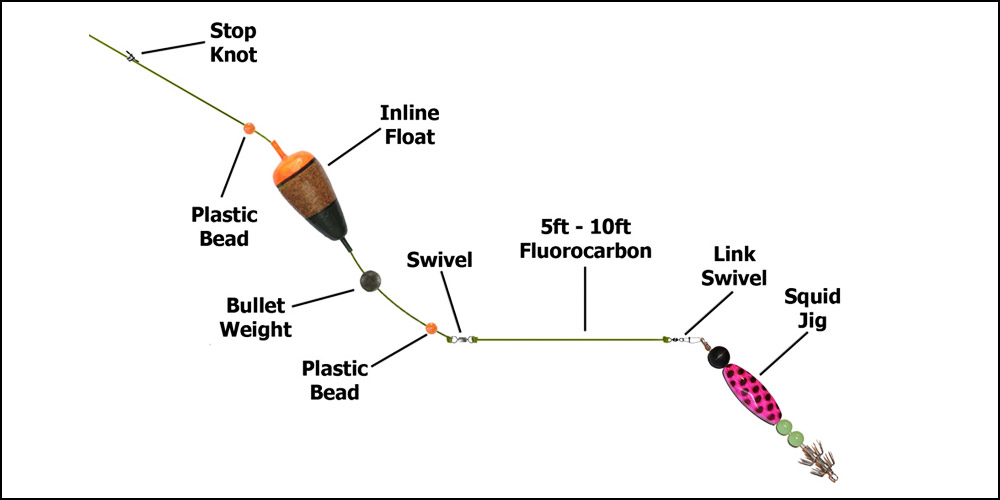
If you decide to fish squid from a boat, then most likely you will do it after sunset. In this case, electric light in the form of an onboard searchlight on a boat is a prerequisite for successful fishing, since squid hunts small fish and crustaceans at night that are attracted by light. You can also equip your line with a handmade flashlight, but it is most effective at depths of 10 meters or more. I want to draw your attention to the fact that when hunting for fish, the squid never stands on a specific area of the sea surface, but constantly moves after the fish.
Moreover, the squid can often change depth, leaving the upper layers of water by 15-20 meters, and after half an hour rising back to the minimum distance from the water surface. In this case, it is best to equip the fishing rod with a reel with a counter (it is possible with an illumination) of the fishing line to constantly record the casting depth of the jig with a “flashlight” and weight.
The main thing when catching squid from any boat is to find the point where it accumulates and hunts for shoals with small fish. If you have a fish finder, then the fishing will be much easier. With it, it is easy to determine where the squid cluster is. Squid is caught from about mid-August (mostly not very large) to the end of October. You can catch it in November, but, as a rule, storms begin in November, and the squid prefers calm or a small wave.
Now let’s talk about boat fishing tactics. Often those anglers who catch squid for a long time and in large quantities at night throw the jig to 20-30 meters and completely lower it to the maximum depth within 1.5-2 minutes. This is followed by a sharp reel at the maximum speed your reel can handle. Often, squid bite in this way – at the bottom or on the descent into the depths, as well as on a sharp rise of the jig to the sea surface.
Some fishermen, making sure that there are no hunting squids in the upper and middle layers of water, lower the jig almost to the very bottom (this is especially simple if the depth overboard does not exceed 12-15 meters, which greatly simplifies the task) and begin to “play” with the jig – raising and lowering with an amplitude of 0.5-1.0 m. A good squid jig has zero buoyancy and plays gracefully and reliably at the bottom, thereby provoking the squid to throw and hold.
Pay attention – there should be a distance of at least 0.5-1.0 m between the bottom of the installation with a jig and the bottom of the sea. Otherwise, instead of squid, an octopus or cuttlefish, which often watch the fish at the bottom, and not in the water column, will be tightly “interested” in your bait. If an octopus or cuttlefish grab a jig with a tentacle, then, as a rule, this is followed by a line break and the loss of all tackle. You have neither the strength nor the ability to tear them off the bottom.
Second. Squid should not be reeled up sharply and then slack! If the fisherman weakens the fight, the squid instantly leaves the jig, and you are left without prey. An average squid, weighing 1-2 kg, feels like a hefty brick and stretches upward without any pauses or respites. A large squid weighing 2 or more kilograms sometimes fights quite hard when striking, actively trying to get off the sharp jig needles. It feels like two bricks hanging on an outstretched arm. A large squid, as a rule, is powerful, even, and abuts for a long time!
One more point should be added to the techniques already described above for fishing at night. Now many Japanese and South Korean firms have begun to produce jigs with a light-accumulative coating, which is activated before fishing using an ordinary lamp (in a boat, you can use a powerful LED flashlight for this purpose). In this case, when you install the jig, instead of a homemade flashlight, you can put two light-accumulative jigs with a weight.
But squid can be caught from a boat not only at night. During the day, this cephalopod species is also very active, but it is difficult to find it in an unfamiliar area of the sea. The best option is if you go to a place already proven over the years, where clusters of different types of squid are constantly found. In this case, during daylight hours, you can use a weighted jig for fishing at depth or without it if you want to try to catch squid near the surface of the water. Often, you don’t even need to make much effort to catch squid on the surface of the water. Smooth and short stretching with a spinning rod, which occurs mainly due to the rocking of the vessel on the waves, and the next squid clings to the jig.
Pros of Offshore Squid Fishing
The squid is much more active at night. It goes to the surface and it becomes much easier for you to catch it and you do not need to lower your jig to the bottom. Besides, when fishing from a boat, you will most often come across squid that hunts in packs and will be able to bring home a much larger catch than if you did it from the shore.
Cons of Offshore Squid Fishing
But fishing from a boat also has many disadvantages that many anglers do not like, which is why they choose calm fishing from the shore.
The first and main disadvantage is the need for equipment. So, at a minimum, you need a boat and lamps that are not cheap. Inshore fishing, you only need a line, a rod, and several squid jigs.
The second disadvantage is fishing mainly at night, which is also not suitable for every angler.
Squid Fishing Lures
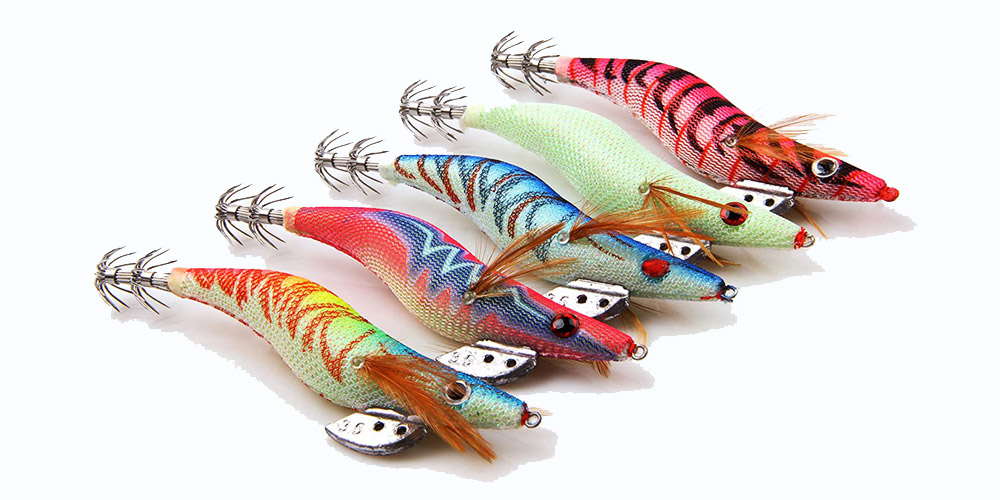
The key to catching squid is to properly prepare your equipment. Someone might tell you that squid can be caught with a tiny hook and piece of bait and they are right. But it is hardly possible to catch more than 2-3 squids per night in this way. If you are aiming for a serious catch, you need to prepare the right gear and tackles. So let’s figure out what you need to successfully catch squid.
Squid jigs can not be found in every fishing store, so you should take care of buying jigs long before your fishing trip. Jigs work most effectively in pairs when you attach them 4 to 5 inches apart and a foot or so above the weight.
For jigs, I recommend choosing lead as it has zero buoyancy and mimics bait behavior well. Besides, it is quite sturdy and durable. In my mid-Atlantic, squid bites best on pink and light green jigs. But in your region, the species and characteristics of squid may differ, so try and experiment with the color of the bait.
Make sure you have enough gear with you to keep fishing even if you lose 2-3 jigs. This may well be since fish can easily grab your bait and drag the jig to the bottom. And if from the shore you still have a chance to return your jig, then when fishing from a boat you can forget about it forever.
If you carelessly caught squid and then noticed that they all turned back and decided to scatter, then I advise you to remove your jig and get a standard hook with bait. If the squid scatters, it means that they have spotted a larger predatory fish that will happily grab your squid jig and drag it under the water with them.
Main Squid Species

Squids are cephalopods that come in all shapes and sizes. The largest of these can weigh 1,000 pounds or more and can be up to 43 feet in length. But anglers of course are faced with smaller species.
✅ Here are the main types of squid:
- Vampire Squid. This is one of the most common squids. They are black or dark brown and have a body shape similar to the cloak worn by vampires. Therefore, they were named so.
- Humboldt Squid. One of the most numerous squids that you can find both onshore and offshore fishing. It inhabits predominantly the eastern part of the Pacific Ocean and is named after the Humboldt Current. This species can be quite large and reach 2 m in length.
- Japanese Flying Squid. These squids have 8 tentacles and large triangular fins.
From Ink to Plate: A Comprehensive Guide to Catching – Preparing – Cooking Squid

Cleaning and Processing Squid
✅ Cleaning and processing squid is an essential step before cooking. Here’s a simple process to follow:
| Step | Instructions |
|---|---|
| Remove head | Hold the squid’s body in one hand and its head in the other. Gently pull the head away from the body, removing the entrails along with it. |
| Remove beak | Locate the squid’s beak, a small, hard structure within the tentacles. Use your fingers or a knife to remove it and discard it. |
| Clean body | Rinse the squid’s body under cold water, gently rubbing the outer skin to remove any slime and debris. Optionally, you can remove the thin, purplish outer skin to reveal the white flesh underneath. |
| Remove quill | Reach inside the squid’s body and pull out the transparent, plastic-like quill. This is inedible and should be discarded. |
| Cut squid | Slice the squid’s body into rings or other desired shapes, and separate the tentacles if you wish to cook them as well. |

Basic Squid Recipes and Cooking Methods
✅ Squid can be prepared in various ways, including frying, grilling, and sautéing. Here are some basic recipes and cooking methods:
| Dish | Preparation |
|---|---|
| Fried Calamari | Coat squid rings and tentacles in seasoned flour or breadcrumbs, then deep-fry in hot oil until golden and crispy. Serve with a dipping sauce like marinara or aioli. |
| Grilled Squid | Marinate squid in a mixture of olive oil, lemon juice, garlic, and herbs, then grill over medium-high heat for a few minutes on each side until lightly charred and tender. |
| Sautéed Squid | Heat some oil in a pan and sauté squid with garlic, onion, and your choice of vegetables for a few minutes until cooked through. Season with salt, pepper, and a splash of lemon juice. This dish can be customized with various flavors and ingredients. |
Tips for Achieving Tender, Delicious Squid
✅ Squid can become rubbery if overcooked or improperly prepared. To achieve tender, delicious squid, follow these tips:
| Technique | Explanation |
|---|---|
| Cook quickly at high heat | Squid benefits from short cooking times at high temperatures to avoid becoming tough and rubbery. |
| Score the squid | Make shallow diagonal cuts in a criss-cross pattern on the squid’s surface before cooking. This makes the squid more tender and helps it cook more evenly. |
| Tenderize with a marinade | Use a marinade containing an acidic component, like lemon juice or vinegar, which helps break down the squid’s muscle fibers and tenderize the flesh. |
| Pound the squid | Gently pound the squid with a meat mallet or the back of a knife to help tenderize it before cooking. |
| Cook squid slowly and gently | For certain dishes like squid stews, cooking the squid at a low temperature for an extended period (e.g., 1-2 hours) can result in a tender texture. This technique is ideal when you want to incorporate the squid into dishes that require slow cooking. |
🔶 By following these tips and techniques, you’ll be able to prepare and cook delicious, tender squid dishes to impress your family and friends.
Ethical Considerations and Conservation: How to Become a Squid Fishing Pro
The Importance of Sustainable Fishing Practices
Sustainable fishing practices are essential to ensure the long-term health of marine ecosystems and the species that inhabit them. Anglers targeting squid should be aware of the potential impact of their activities on the environment and take steps to minimize any negative effects. This can include adhering to local regulations, only taking what you need, and using catch and release techniques when appropriate.
Regulations and Limits to Be Aware of
Different regions have specific regulations and limits regarding squid fishing, which are designed to help maintain healthy squid populations. It’s essential for anglers to be familiar with the regulations in their area, including bag limits, size limits, and any gear restrictions. Always check with your local fisheries department or governing body to ensure you are aware of the most up-to-date regulations.
Catch and Release Considerations
While catch and release is not as common with squid fishing as it is for other species, there are times when releasing a squid may be the most responsible choice, such as when it is under the legal size limit or if you’ve already reached your bag limit. When practicing catch and release, anglers should handle squid as gently as possible to minimize stress and the risk of injury. Use a net to land the squid, minimize handling, and release the squid back into the water as quickly as possible to increase the chances of survival.
❓ Squid Fishing FAQs ❓
✅ Here I have collected for you the most frequently asked questions that fishermen, especially beginners, have. If you are going on your first squid fishing, then it will be useful for you to read the section below.
🔶 Remember to always respect the local laws and regulations, practice sustainable fishing, and consider the welfare of the species you are targeting.
In Conclusion: Unlocking the Secrets of Cephalopod Catching
In this comprehensive guide on catching squid, we’ve covered various aspects such as understanding squid biology and behavior, selecting the right equipment and gear, mastering different techniques and tactics, handling and cooking squid, and embracing ethical considerations and conservation practices. By gaining knowledge in all these areas, anglers can increase their chances of successfully catching squid and enjoy a rewarding experience.
Now that you’re equipped with this wealth of information on catching squid, it’s time to put the guide into practice. Head out to your favorite fishing spot or explore new locations, and use the techniques, tips, and advice shared in this article to maximize your success. Remember that practice makes perfect – the more you fish for squid, the better you’ll become at understanding their behavior and fine-tuning your approach.
We’d love to hear about your own experiences in catching squid and any tips you’ve discovered along the way. Feel free to share your stories, insights, and even your favorite squid recipes in the comments section below. Your knowledge and experiences can not only help other anglers improve their squid-catching skills but also contribute to building a supportive and informative community around this exciting and rewarding pastime.
🔶 Now is one of the best times to catch squid thanks to the modern tackle and squid hunting methods. I love catching squid for juicy seafood and some of the best baits I can catch many species with. Fishing for squid is not as difficult as it might seem at first glance. The main thing is to find the right equipment and fishing spot. Hope my guide can help you with this.

I live in Tenerife (Canary Islands) for the last 10+ years and share my daily fishing experiences on my website. Many years of personal experience as a fisherman and the vast experience of my friends allow me to write professionally on any fishing topics (from choosing a flashlight and equipment to deep-sea fishing).
All of my advice is based on practical real-world experience and will be useful to both novice anglers and professionals. Read more about the author.
Affiliate Disclosure: FishReeler.org sometimes gets paid for listings, through sponsors or affiliate programs like Amazon, Ebay, Cabelas, Bass Pro Shop, Shimano, Daiwa, Rapala, Renn, Okuma, KastKing, etс. Clicking a link helps keep FishReeler.org free, at no extra cost to you!
About the author: Each article is verified by the fishing expert Sergio Smirnoff. The articles are written by professional and amateur fishermen with 20+ years of fishing experience.
Note: The views and opinions expressed in this article are those of the authors and do not necessarily reflect the official policy or position of any agency. The articles are for informational purposes only, share your opinions in the comments and join the fishing discussions, let's share our fishing experiences together!

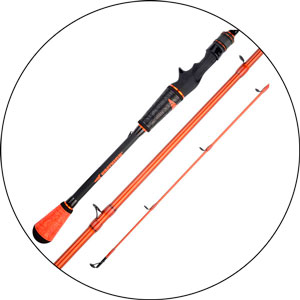
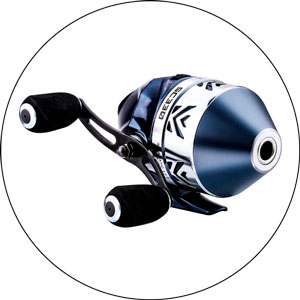

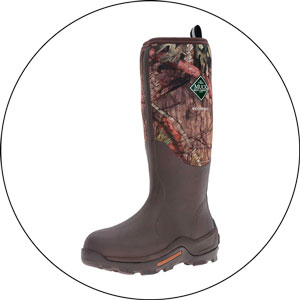
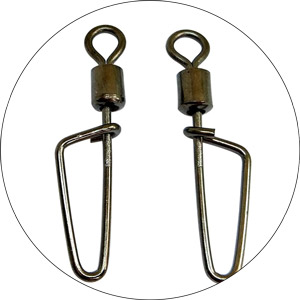
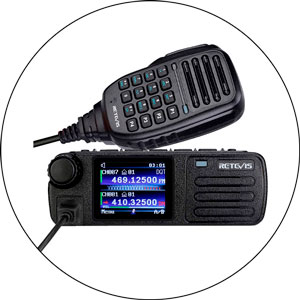
Vacationed in November on the island of Gran Canaria place Mogan. There at night fishermen near the shore (30-70 meters) were catching white squid. Probably it was the best time for biting. Each of the bottoms had no problem catching 5 pieces weighing up to 1 kg. It was amazing.
Here are some essential tips for squid fishing that you might find helpful:
I hope you find these tips useful for your squid fishing adventures!
Here are some general squid fishing tips that might be useful for enthusiasts:
I hope you find these tips helpful for your squid fishing adventures!
It seems like it might just be a case of bad luck with the numbers. I read that someone only caught 5 squids throughout an entire winter once. You mentioned using bait, but have you also tried using a dressed spinner? I’ve seen people use one alongside bait, and sometimes even food with a fishing buff. Dressed spinners are known to increase the bite rate, so it could be worth a try!
Winter is typically the best time for catching squid. It’s worth trying any rock faces or wharves in a harbor that have lights around. You can even bring your own lights, but make sure to fish on the edge of the lit area, in the darker sections. The light is intended to attract baitfish, and the squid usually waits on the outskirts to catch any stragglers.
Using a 5-gallon bucket filled halfway with ice and water, along with a box of kosher salt, creates an excellent brine for squid. The cold temperature helps remove them from Yo-Zuri lures, and the brine toughens and preserves them for use as bait. The shock also prevents them from releasing ink into the pail. This method has been used for years to jig up squid for bass and other top predators with great success.
Incorporating a wire frame with hooks in the skirt has also proven effective. Brining was found to be helpful in preventing blowouts of the body tubes during deep drops with swordfish. Using high salt concentrations even allowed the squid to survive umbrella trolls. Just be careful not to mix up the brined squid with the calamari ones in the freezer!
Is cleaning squid too much effort? Actually, squid is quite easy to clean! Just follow these simple steps: remove the head, pull off the wings along with the outer membrane, and then remove the quill and remaining guts. It takes only about 30 seconds per squid. After that, slice them into rings and fry them with garlic, salt, and pepper for less than a minute. Add a squirt of lemon juice, and you’ve got a delicious dish! Check out this video for a quick tutorial: https://www.youtube.com/watch?v=xM2R_evubhI
Although I’m not specifically fishing for Humboldt squid, I believe the tactics are quite similar. One suggestion is to use a squid jig (the Yo Zuri brand is a popular choice). Tie a dropper loop to easily swap between different weights, typically ranging from half an ounce to 2 ounces, depending on the location. About 12 inches above the first loop, tie another for the squid jig.
To fish, drop your line into the water until you can find the bottom with your weight. Jig near the bottom, varying your speed and technique until you find what works. When a squid hits the jig, it’ll feel like a fish. Their tentacles get caught in the hooks, and you’ll feel something pulling – start reeling! Be prepared for some ink squirting when it comes up, so wearing black clothing is a good idea.
As for finding squid, they’re usually most active at night because they’re nocturnal. In New England, for example (based out of the Boston area), the season typically runs from late April to early June. Squid are attracted to light, so fishing from a boat with underwater or floodlights, or from a bridge, pier, or dock with plenty of light is effective. Some people even hang Coleman propane-powered camping lanterns over bridges with ropes to attract baitfish and squid. Marinas are also popular spots, and you can find squid fishing charters in Rhode Island.
The routine for the past five weekends has been to start the night off at 10 pm, jigging up a dozen or two large squids. After that, move on to popular striper spots nearby and rig up a baserunner with a 7/0 octopus or circle hook and a 40lb braid straight to the hook. Hooking the squid through the top of the mantle and casting to spots where stripers are likely holding.
Usually, at least one striper is caught every night, but they aren’t always keepers. The stripers caught range from 15 to 33 inches. A couple of weekends ago, the first bluefish of the season was caught on the north shore, measuring just 12 inches. After running out of bait at around 4 am, the last 4-inch squid was used, and the bluefish nailed it as soon as it hit the water.
That’s just the most basic way to do it. You can rig up to 3 or so squid jigs/dropper loops off one setup to maximize your time, but the trade-off is that it’s harder to manage multiple jigs as they can get caught on things, including each other. I’ve seen pros use no weight and just snag the squid with jigs or treble hooks right on the top of the water too.
Squid also travel in fairly large pods, so if there is one, there is generally a lot of them. It’s very cool to see a huge pod of a few hundred squid swim by.